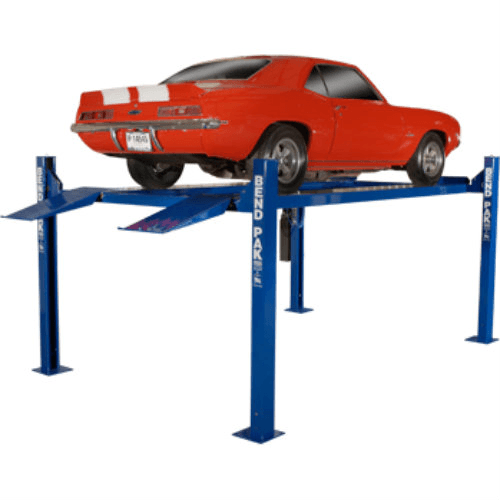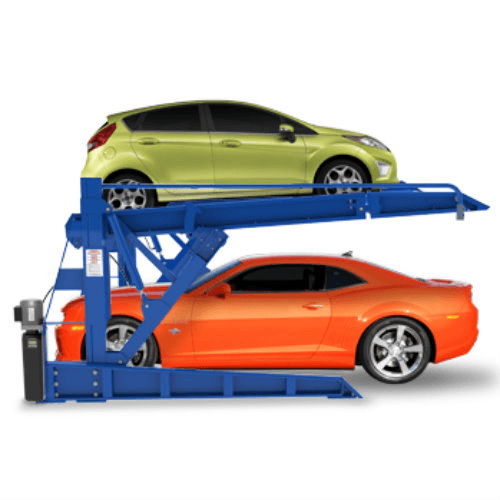Vehicle Lifts: Different Types and how to Choose the Right One
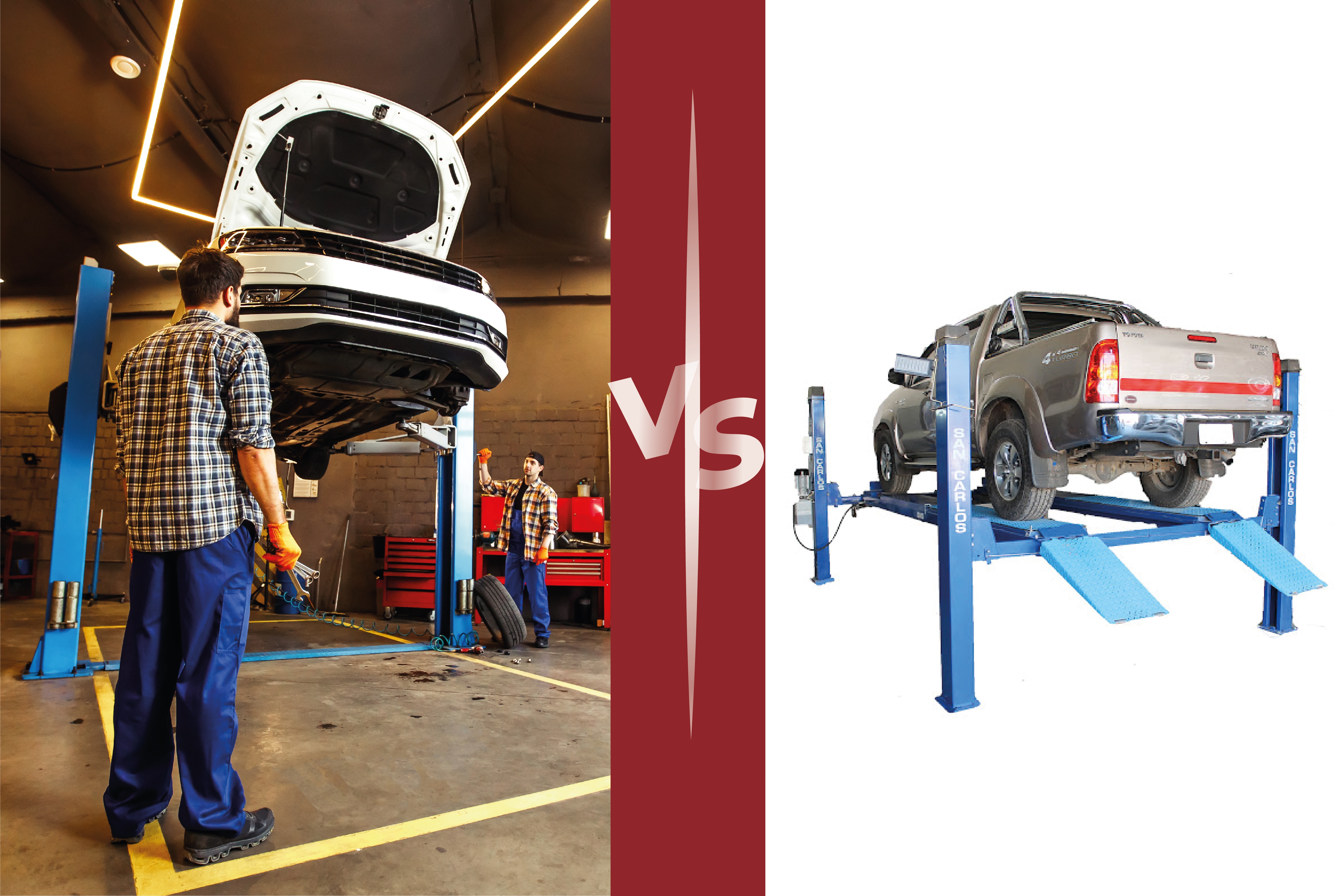
Vehicle lifts can be one of the most important investments you can make for your auto shop or garage.
But with the market full of brands and models, picking the right one can be difficult for beginners. This is why we've put together this compendium of our favorite vehicle lifts. A dossier if you will of the industry's biggest brands and models. From two post to four post and even scissor lifts, we've got you covered.
So sit back, relax and let us guide you through this simple vehicle lift selection process.
What is a Vehicle Lift?
If you've landed on this article, you can skip through this next paragraph. This is standard procedure to inform those unaware.
A vehicle lift is one of the most important items of display of most service and repair bays. They are an integral part of vehicle maintenance and repair tasks. Used more times per day than any other piece of equipment in your shop, lifts are pieces of equipment that should be in every shop.
The market’s need for lift production has led to many different types of lifts all serving different types of shops as well as clients. The brand you decide to go to is open for discussion but for now, here are the different types of lifts and their uses.
Two Post Lifts
Often cited as the most common type of auto lifts available. Two post lifts are known for their two sturdy posts and supportive stabilization arms. Two post lifts are a more cost-effective alternative for small shops or amateurs starting to get into the repair industry. They are also great considering the small footprint they leave in your garage for space-saving convenience. But more on this later.
Now, there are different types of two post lifts as well so it is important to learn the difference between them. For starters, two-post lifts can be considered symmetrical, asymmetrical, or versymmetrical.
Symmetrical lifts are easier to identify because their posts face each other directly. And the support arms assemblies each hold about 50% of the load. While asymmetrical lifts have swing arms that are not the same length in the front and back and even have a rotated post design. The third option available is the versymmetrical lift. These provide users with the ability to take advantage of being both asymmetric and symmetric simultaneously.
Many argue that versymmetrical lifts are two lifts in one. Allowing operators to properly accommodate cars, trucks, and vans all within the same service bay. Versymmetric two post lifts are capable of lifting all 20 of the most popular service vehicles. These include Ford F-Series, Chevy Silverado, Nissan Altima, and the GMC Sierra among others.
Other types of two-post lifts include overhead lifts and floorplate lifts. Overhead lifts have the hydraulic hose and equalization cables running through the top of the lift. While such cables run on the bottom in floorplate lifts.
Overhead Lifts
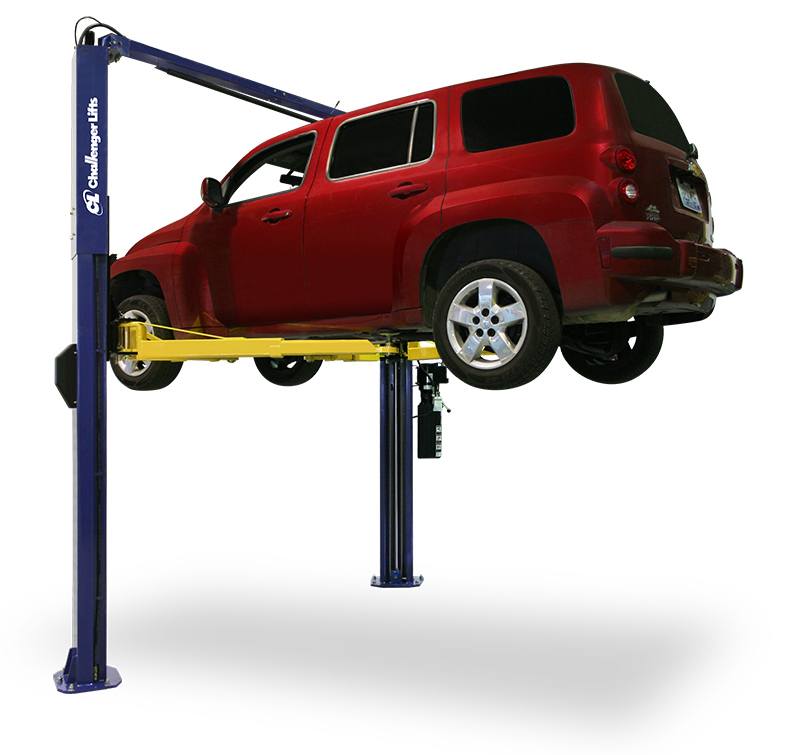
Floor Plate Lifts
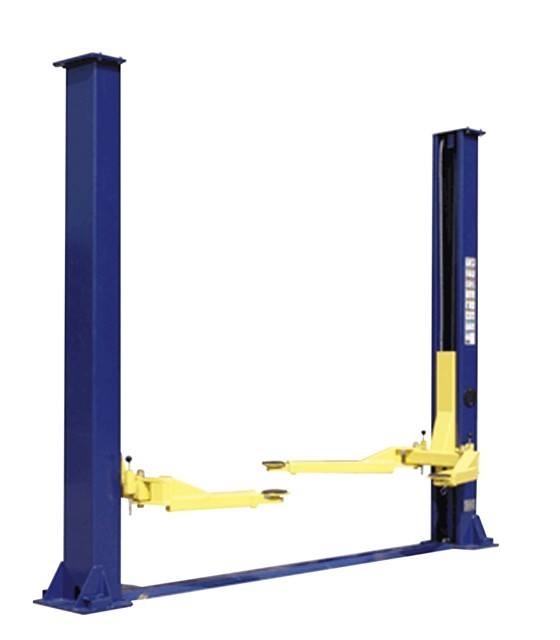
Despite the differences among two post lifts they are all perfect for servicing lighter vehicles and taking up very little space. If you have a bigger garage and are looking to service trucks or larger vehicles, two post lifts might not be the solution. These lifts also need more attention to detail in order for them to reach designated vehicle lifting points.
Overall
Advantage
- Cost-Effective option for people just getting into the auto shop world.
- Take up very little space.
Disadvantage
Can be time-consuming to set the four lift points on some vehicles (medium-duty trucks for example). Because of their kick-up frame sections.
Four Post Lifts
For most heavy vehicle lifting, chances are you will see a four-post lift used. These lifts can hold higher capacities compared to two-post lifts because of the extra support columns.
Four post lifts are user-friendly and have a wider range of clientele. But are especially popular among hobbyists; home garages and any size shop. This is because these lifts don’t need floor anchors. But, as with everything, there are flaws in four-post lifts. The most obvious is that if you plan to use this type of lift for wheel service, you will also want to invest in sliding bridge jacks to lift said wheels off the runway.
With four post lifts, you also get variety as well as lifting capacity. This pretty much narrows down your search to a more specific weight group.
The first type of four-post lift is the open front lift which comes without a front crossbar. Allowing operators to easily enter and exit from beneath the vehicle. This makes front-end adjustment fast and trouble-free. The second option is the closed front four post lift which means that the front of the lift has the aforementioned bar in the front. It all depends on the type of work you’ll be doing on your vehicles.
Another important characteristic found in four-post lifts is the lifting capacity available. For most small vehicles such as midsized sedans and small trucks a lift with a capacity of up to 9,000 lbs. will do but there are four post lifts that range from 6,000lb. lifting capacity up to even 40,000 lb. lifting capacity! JMC has a wide variety of four-post lifts currently on sale with up to 30% off on selected brands and products.
Four posts lifts may be a bit pricier. But if you’re looking for mobility, capacity, and storage, you can’t go wrong with a four-post lift.
Overall
Advantage
-
Four post lifts only require a 115-volt power supply while 2 post lifts require 220-volt.
-
More variety in accessories and weight capacities.
Disadvantage
-
A tad pricier
-
Depending on the type it may take up more space.
Scissor Car Lifts
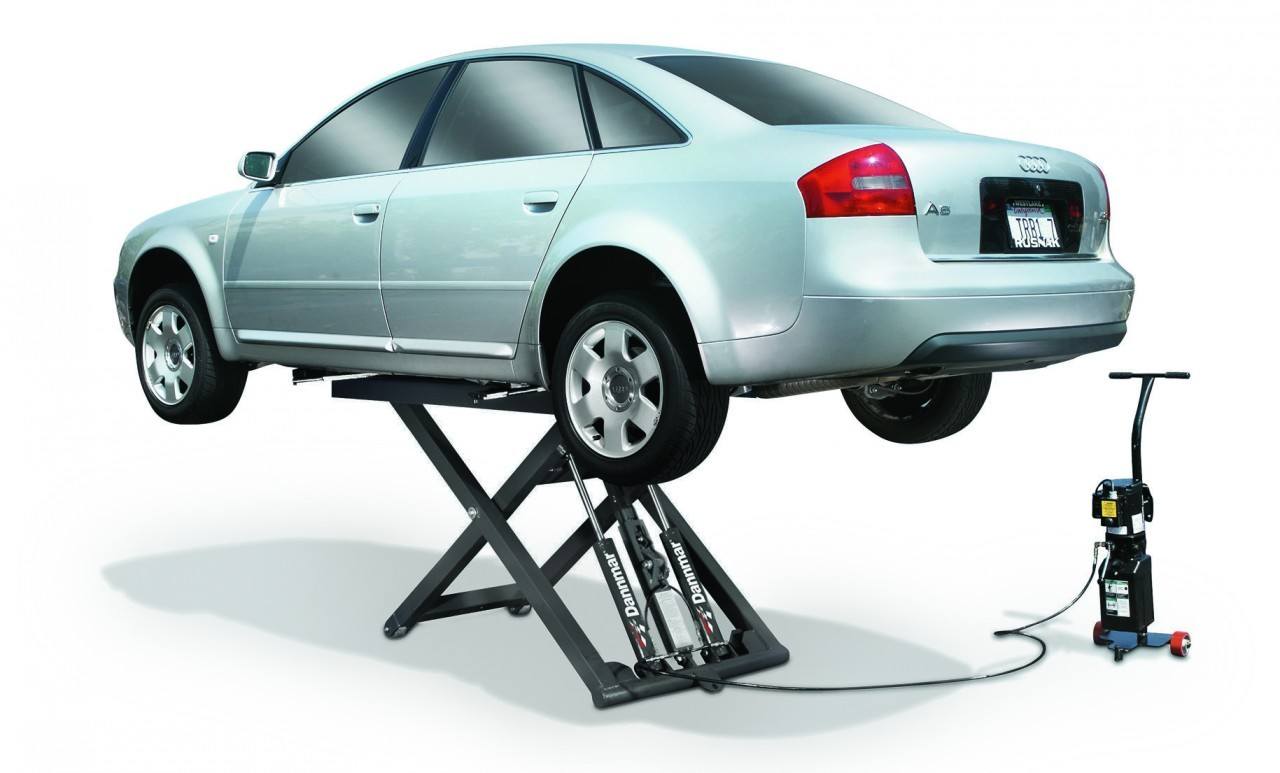
Scissor vehicle lifts is a broad term. But the word encompasses any type of lift that raises their vehicles with accordion-like mechanisms beneath the runways.
Depending on the configuration of the cylinders and raising rods, scissor lifts can be either drive-on or four-arm style lift. Scissor lifts are commonly used as a midlift style hoist. They can also be used for wheel service where lifting your vehicle to great heights is not required.
Scissor Lifts can also be divided into three groups: X type, parallelogram type, and pantograph lifts.
Like four post lifts, scissor lifts also come in a wide range of heights and capacities to suit the needs of either professional shops or hobbyists.
Low rise scissor lifts are known for raising up to 36 inches off the ground. Mid-rise lifts can raise between 36 and 48 inches and full rise scissor lifts can go anywhere above that. You might imagine all scissor lifts as small but parallelogram style lifts particularly are some of the heaviest lifters on the market. In fact, scissor lifts increase in size in higher weight categories.
These lifts are also known for keeping a low profile which makes mounting pretty much hassle-free. Very little is required beyond positioning your vehicle over the scissor lift.
Overall
Advantage
- Depending on size and capacity, scissor lifts tend to keep a low profile.
Disadvantage
- Slight tweaking might be necessary for frame engaging style scissor lifts.
Portable Car Lifts
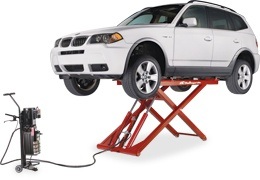
When space is your primary concern you can’t overlook the idea of a portable car lift. Some of us have limited space in our garages or shops and here is where portable lifts can be of use. There are many different types of portable lifts because most brands offer their lifts with the option of a portable version. But be aware that with portable vehicle lifts you trade function for form. That means that due to the space problem, you will end up buying a portable four-post lift. A lift that might not have all the functionalities and or gadgets found in the non-portable version. You might also want to check the capacities of these bad boys before you try and hoist an oversized truck.
Overall
Advantage
- The space you can save using a portable lift is unlike no other vehicle lift out there.
Disadvantage
- It is pretty clear that we lose out on all lot of bells and whistles of other lifts when we choose a portable lift.
In ground Car Lifts
For years, in-ground lifts were the norm in almost all large shops and or rental businesses. These allowed vehicles to be hidden under the floor of shops when the car wasn’t in service. They can be either elevator style or scissor lift style and are good choices for keeping the ground clear of clutter.
But, with in-ground lifts, the added space also manifests itself in its initial price. If you take a two-post lift and compare it to an in-ground lift with similar qualities, chances are the latter’s price is steeper. Not only that but added expenses can also include cutting up and preparing the shop’s concrete for the car lift’s body. Something that can set you back thousands of dollars.
In-ground lifts have also garnered a bad reputation for being harmful to the environment and susceptible to oil leaks.
Overall
Advantage
- When a vehicle is not being serviced the elevator (or scissor) like characteristic allows the vehicle to be stored underground.
Disadvantage
- There are more disadvantages but the most important (aside from cost) is the difficulty to detect oil leaks. Because of that, the EPA has mandated leak safeguards around all installed in-ground lifts. These lifts are the only ones in the industry that require this oil barrier that in conclusion can add to the cost of ownership.
Mobile Column Car Lifts
The idea behind mobile column lifts is actually very simple. Say you want to lift a large vehicle (a city bus for instance) and are looking for added support. Mobile Column Lifts allow you to add or remove more posts. There are also advanced models that come with wireless communication features. This allows one operator to lift platforms simultaneously of up to eight independent post structures.
Currently, mobile column lifts are wheel engaging but also use lifting forks instead of runways to engage the vehicle. These lifts are more for large shops and are rarely seen in garages due to price and the room the added columns take up.
Parking Lifts
There is a common misconception when it comes to parking lifts and that is that you can use them to work on your vehicles as well as any other type of lift. This is false. Parking lifts leave smaller footprints but automotive service, maintenance and repair is out of the question. These lifts are strictly for parking.
Parking lifts feature a full drive-on deck as opposed to two runways. The lifting platform is supported by either a single post or two posts and is designed so that you can park another vehicle beneath it.
Overall
Advantage
- A single parking spot can now successfully do the job of two.
Disadvantage
- Cannot service, repair, or perform maintenance on vehicles.
There are many benefits that come with purchasing a vehicle lift. The first thing you must know before going off to buy one is to make sure you know the space you’d like and need it to take up. As well as budget and which of the types we mentioned in this article better suit your needs as a shop owner or hobbyist. You might also want to ask yourself if in your garage or shop you have enough ceiling height to accommodate a 72-inch under-car height. Do you have concrete that is thick enough? And also, do you want a lift that will require 115 or 220-volt power?
In the next few articles, we're going to go in-depth to everything you need to know about every category of lift. We're also going to talk about our best sellers and what makes them so coveted. We’re also going to speak about the first tools every new shop needs in their arsenal. As well as the top brands that make them.
Want to learn more about vehicle lifts and automotive equipment in general? Be sure to contact one of our industry experts and ask about our current specials.


